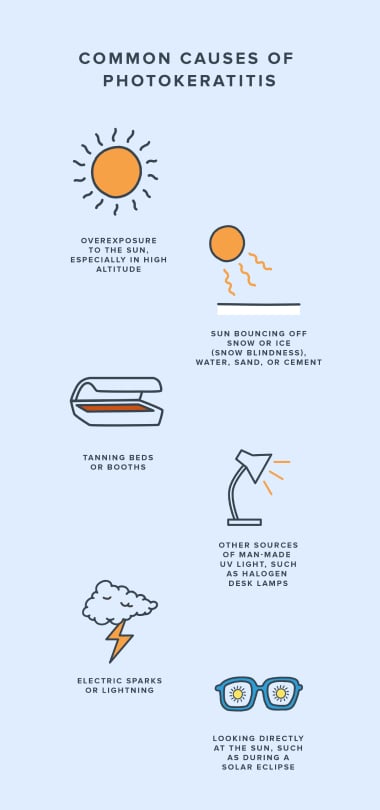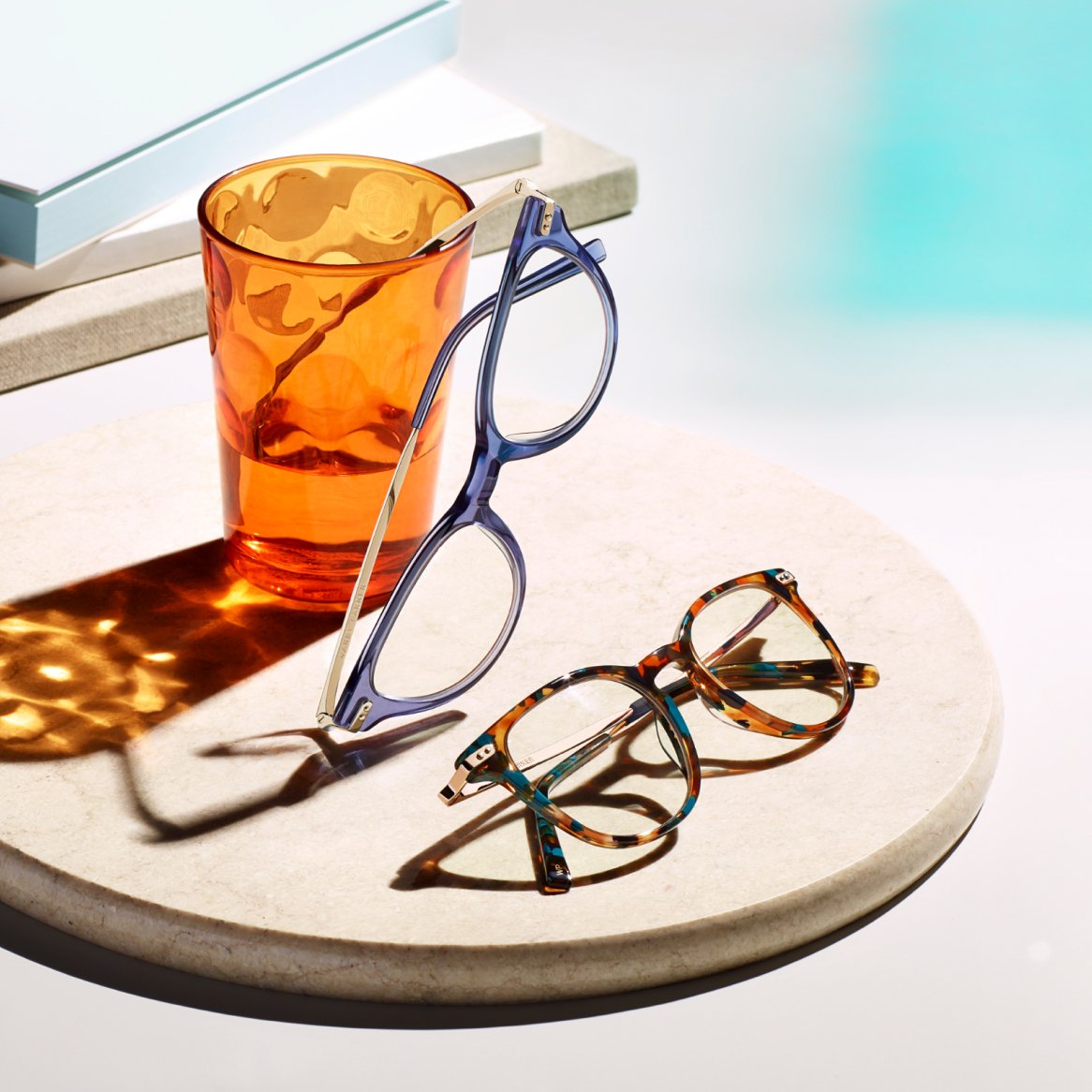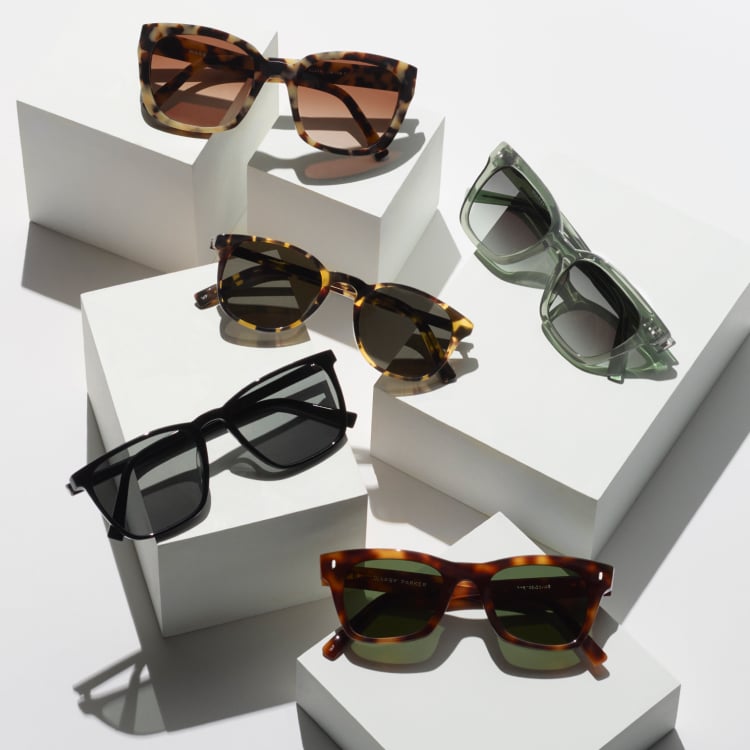Photokeratitis, or ultraviolet keratitis (UV keratitis), is a temporary eye condition that’s a lot like a sunburn. But instead of your skin being affected, it’s your eyes. In fact, photokeratitis is sometimes referred to as sunburned eyes, and it can cause some pretty intense eye pain.
In this guide, we’ll discuss the causes, symptoms, and treatment for photokeratitis and explore what you can do to prevent it.
Photokeratitis Causes and Risk Factors
Photokeratitis happens when unprotected eyes get too much exposure to ultraviolet (UV) light rays. This causes damage to the cells of the cornea (the clear dome covering the eye). Photokeratitis can also affect the conjunctiva, which is the tissue covering the insides of the eyelids and the whites of your eyes. Both main types of UV rays—UVA and UVB—can damage your eyes.
Outdoor activities can increase your risk of photokeratitis, especially at high altitudes or in super sunny locations. It can occur when sunlight reflects off of surfaces like snow, ice, water, or sand. Looking directly at the sun—including during a solar eclipse without a viewing device—can also cause photokeratitis.
What Is Snow Blindness?
Snow blindness is a type of photokeratitis caused by sunlight reflecting off of ice or snow. It’s common near the north or south poles or in high altitudes where the air is thin.
People who engage in snow activities in other places may also get photokeratitis. If you go skiing, snowmobiling, or mountain climbing, be sure to use proper eye protection to help avoid snow blindness.
Other Causes of Photokeratitis
You can get photokeratitis from UV light sources other than the sun, including:
- Tanning beds or booths with artificial UV lights
- Certain welding equipment
- Floodlights used in photography
- Laser lights
- Halogen lamps or other very bright lights like highway lights
- Electric sparks
- Lightning
Photokeratitis Symptoms
Because photokeratitis is like an eye sunburn, symptoms may take a few hours to show up after sun exposure, much like a sunburn on your skin. And your symptoms will be more severe the longer you’re exposed to UV light. Try to resist the urge to rub your eyes, as that could cause more discomfort (much like rubbing a sunburn on your skin).
Possible photokeratitis symptoms include:
- Eye pain
- Burning sensation
- Redness of the eyes
- Blurry vision
- Watery eyes
- Eye swelling
- Light sensitivity (photophobia)
- Gritty sensation or the feeling of something stuck in the eye
- Headache
- Twitchy eyelids
- Temporary vision changes, such as a halo effect around lights
How Long Does Photokeratitis Last?
Photokeratitis is temporary and tends to go away with rest after a day or two. However, long-term UV exposure could put you at risk for other eye conditions, like cataracts and macular degeneration.
Photokeratitis Treatment
It’s best to see an optometrist or ophthalmologist to diagnose photokeratitis. They’ll have the expertise to assess the severity and offer the best advice for treatment to ease your symptoms.
Your eye doctor may recommend:
- Going into a dark room: Avoiding the light as much as possible can help with symptoms.
- Taking out contact lenses: Experts recommend removing your contacts immediately if you have symptoms of photokeratitis.
- Using eye drops: Your doctor may suggest eye drops to help lubricate and soothe your eyes. Or they might prescribe eye drops with antibiotics to ward off or treat an infection.
- Using a cold compress: A cold washcloth or ice pack placed over closed eyes can ease some of the discomfort and swelling of the eyelids.
- Taking pain medication: A doctor can suggest a pain reliever medication to help ease the pain.
How to Prevent Photokeratitis
You can help prevent photokeratitis by not looking directly at any source of bright UV light. Say it with us: Looking directly at the sun will damage your eyes. If you want to look at a solar eclipse, be sure to use special, safe solar-viewing glasses and handheld devices.
Always wearing protective eyewear that’s appropriate for your activities can help prevent photokeratitis. If you’ll be outdoors, that means UVA- and UVB-blocking sunglasses (or snow goggles). Special equipment for welders can help prevent photokeratitis as well.
Rest Your Eyes and See Your Eye Doctor
If you think you might have photokeratitis—or are having any eye issues—make an appointment for an eye exam. And take the necessary steps to protect your eyes from photokeratitis in the future. Your eyes will thank you.








